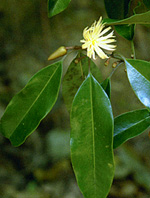 |
This primitive family includes the single genus Galbulimima, found in rain forests from south-east Asia to north-east Australia as far south as northern New South Wales.
Characteristic features of the family Himantandraceae in Australia include: - trees with aromatic, simple, alternate leaves covered when young by umbrella-shaped (peltate) scales and with translucent oil-dots
- flowers bisexual, white or red, solitary in the leaf axils, enclosed when young by two leathery sepals and with 4-7 inner perianth lobes
- stamens numerous, flat and petal-like with marginal pollen-sacs
- ovary comprising 7-15 more or less free carpels which later coalesce into a gall-like , fleshy fruit
Description
Evergreen trees. Internal secretions not obvious. Plants glabrous or with peltate scales. Leaves alternate and spiral, or distichous, petiolate. Stipules absent. Lamina simple, symmetric, lanceolate, ovate, elliptic, oblanceolate or obovate; base cuneate; margins entire, ±flat; venation pinnate, with the midrib conspicuous, and the tertiary venation reticulate; surfaces not punctate; leathery. All the flowers bisexual. Inflorescences axillary, consisting of cymes or solitary flowers. Bracts and bracteoles present. Pollination by ?insects. Flowers fragrant or malodorous, stalked. Floral disc absent; nectaries absent. Perianth regular, of 2 dissimilar whorls, of 1 whorl only, or all whorls ±similar or vestigial or absent, imbricate in bud. Calyx segments free or fused, with 2 sepals or lobes; calyx cup-shaped; herbaceous or papery. Corolla segments free, with 7–9 petals, with no clear relationship to the sepals or calyx lobes, white or red, without contrasting markings, membranous or papery; claws absent; lobes ±entire. Fertile stamens 25–30, not clearly correlated with the sepals or calyx lobes, free of the corolla, free of the ovary and style, distinct from each other, all ±equal. Staminodes present, petaloid, subulate. Staminal filaments flattened and petaloid, subulate, each with a pair of embedded anther-sacs on each surface near the base. Anthers not versatile, opening outwards or inwards by longitudinal slits, 2-celled; appendages absent or apical. Ovary superior and sessile. Carpels 7–15, free from each other or becoming fused; ovary with 7–15 locules. Style terminal, single and unbranched, branching from the base, or absent and the stigma ±sessile. Ovules 1 (–2) per locule, stalked; placentation laminate. Fruit fleshy, indehiscent, apparently a berry, but truly an aggregate fruit (syncarpium); the perianth on the maturing fruit deciduous or rotting or liquefying. Disseminule micro-surface ±smooth, red or pink, glossy. Seeds 4–10 per fruit. Aril ?absent. Cotyledons 2. Embryo ?straight.
(Note: this description has been generated from the coded data compiled for the key. Any errors in the key data will be reflected in the descriptions.)
A treatment of the family Himantandraceae has not yet been published in the Flora of Australia. It will appear in Volume 2.
Australian genera of Himantandraceae (as recognised for the Flora of Australia)
Galbulimima

|
  |

Galbulimima baccata (flower)
Photo: J.Williams © J. & M.Williams

Galbulimima baccata (shoot tip with flower bud)
Photo: J.Williams © J. & M.Williams
|
 |
|